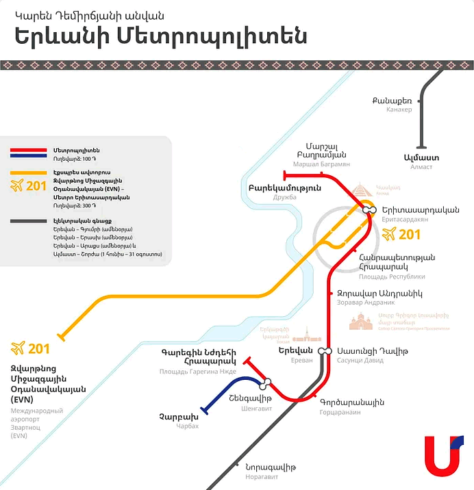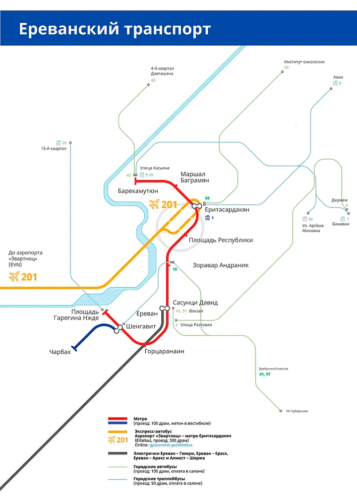El metro de Erevan, conocido localmente como «Երևանի մետրոպոլիտեն» (Yerevani Metropoliten), es el sistema de transporte subterráneo que sirve a la ciudad de Erevan, la capital de Armenia.
Inaugurado el 7 de marzo de 1981, este metro ha sido muy importante en la vida urbana de los residentes y visitantes por igual. Cuenta con una red que comprende una línea de 13.4 kilómetros (8.3 millas) y 10 estaciones.
Mapa del metro
Presentamos el mapa del metro de Erevan en dos versiones diferentes. Haga clic en la imagen para hacerla más grande.


Horarios
- Lunes a viernes: 06:30 a 23:00.
- Sábados y domingos: 07:00 a 23:00.
Tarifas del metro de Erevan
El metro de Erevan ofrece una variedad de tarifas para sus usuarios, adaptándose a diferentes necesidades y perfiles. Aquí tienes una tabla con los precios más comunes en drams armenios (AMD) y su equivalente en dólares estadounidenses (USD) para que los turistas se hagan una idea mejor del precio:
| Tipo de Boleto | Precio en AMD | Precio en USD |
|---|---|---|
| Boleto sencillo | 100 AMD | 0.25 USD |
| Abono mensual | 4500 AMD | 11.25 USD |
| Boleto para turistas (3 días) | 1000 AMD | 2.50 USD |
| Boleto para estudiantes (mensual) | 3000 AMD | 7.50 USD |
El boleto sencillo cuesta 100 AMD, lo que equivale aproximadamente a 0.25 USD, y permite un viaje en cualquier línea del metro. El abono mensual, por otro lado, cuesta 4500 AMD (alrededor de 11.25 USD), y es ideal para quienes utilizan el metro a diario.
Tarjetas especiales y descuentos
El metro de Erevan también ofrece varias tarjetas con descuentos y beneficios especiales:
- Tarjeta para turistas: Esta tarjeta permite viajes ilimitados durante tres días y cuesta 1000 AMD (2.50 USD). Es perfecta para quienes visitan la ciudad y desean moverse de manera rápida y económica.
- Tarjeta para estudiantes: Los estudiantes pueden optar por una tarjeta mensual a un precio reducido de 3000 AMD (7.50 USD), facilitando su movilidad diaria hacia y desde las instituciones educativas.
- Descuentos para niños: Los niños menores de 7 años pueden viajar gratis, y hay descuentos especiales en fechas conmemorativas y eventos específicos, como el Día Internacional del Niño, cuando la entrada es gratuita para menores de 16 años.
Sitio web oficial
- Web oficial del metro de Erevan: www.yer.metro.am
Historia del metro
El proyecto del metro de Erevan comenzó en 1972, cuando la ciudad necesitaba urgentemente mejorar su infraestructura de transporte. El gobierno soviético decidió que Erevan, con su creciente población, se beneficiaría de un sistema de metro. Se planificó inicialmente como una red de tranvías rápidos con tramos subterráneos.
Las obras comenzaron oficialmente en 1972, con la primera fase que incluía cuatro estaciones: «Lenin Square» (ahora «Plaza de la República»), «Studencheskaya-Teatralnaya» (ahora «Yeritasardakan«), «Barekamutyun» y «Kievyan«. Estas estaciones se completaron en 1977, tras superar dificultades geológicas significativas como terrenos basálticos y aluviales.
El 7 de marzo de 1981, el metro se inauguró oficialmente. Este evento marcó el inicio de una nueva era para la movilidad en Erevan. La construcción continuó con la expansión de la red, y para 1983, se inauguraron las estaciones «Sasuntsi David» y «Garegin Nzhdeh Square«.
En 1987, se abrieron las estaciones «Zoravar Andranik» y «Marshal Baghramyan«. Posteriormente, en 1996, se añadió la estación «Charbakh«, siendo la última en abrir antes de que el proyecto de expansión se suspendiera debido a la inestabilidad económica tras la independencia de Armenia.
Varios ingenieros y compañías constructoras participaron en este monumental proyecto. «Armgyprotrans» fue una de las principales firmas de diseño e ingeniería involucradas. Los ingenieros trabajaron en condiciones difíciles, enfrentando tanto retos técnicos como geológicos. La planificación y la ejecución de las fases fueron supervisadas cuidadosamente para garantizar la seguridad y la eficiencia del sistema.
El metro de Erevan no solo ha sido una infraestructura crucial para el transporte, sino también un símbolo de resistencia y adaptación a lo largo de las décadas. Desde su inauguración, ha servido a millones de pasajeros y ha jugado un papel clave durante eventos críticos, como el terremoto de Spitak en 1988, donde algunas estaciones se usaron como refugios de emergencia.
Historia del mapa del metro de Erevan
El diseño original del mapa del metro de Erevan fue encargado en la década de 1970, junto con el desarrollo del sistema de metro en sí. Desde el principio, se necesitaba un mapa claro y efectivo para orientar a los pasajeros en la nueva red subterránea de la ciudad.
En los primeros años, los mapas fueron diseñados por ingenieros y arquitectos soviéticos, quienes utilizaron técnicas de diseño estandarizadas de la época. La responsabilidad de la creación y actualización del mapa recaía en el equipo de planificación urbana de Erevan y la empresa constructora «Armgyprotrans«, que también estuvo a cargo del diseño de las estaciones y los túneles.
Con el tiempo, la expansión del metro y la evolución tecnológica permitieron mejoras en los mapas. En la década de 1980, Alexander Glazunov, un renombrado diseñador, participó en la modernización del diseño del mapa, asegurando que fuera más accesible y fácil de entender para todos los usuarios del metro.
A medida que la red se ampliaba, con la inclusión de nuevas estaciones como «Garegin Nzhdeh Square» en 1987 y «Charbakh» en 1996, el mapa del metro se actualizaba regularmente. Las actualizaciones no solo añadían nuevas estaciones, sino que también mejoraban la representación gráfica para reflejar mejor la realidad del terreno y las necesidades de los pasajeros.
En la actualidad, el mapa del metro de Erevan se ha digitalizado, permitiendo a los usuarios acceder a versiones interactivas a través de dispositivos móviles y en la web oficial del metro. Estas versiones digitales son mantenidas por el equipo técnico del metro, quienes se aseguran de que la información esté siempre actualizada y sea precisa.
Datos adicionales
El metro no solo es un medio de transporte, sino también un refugio histórico y cultural. El metro permite llegar a los principales sitios turísticos de la ciudad, por ejemplo a estación «Republic Square» es famosa por su proximidad a la majestuosa Plaza de la República, un sitio importante por su espectáculo de fuentes danzantes. Los sitios más descatados serían los siguientes:
- Plaza de la República (estación Republic Square, Línea 1): Centro de la ciudad, famosa por sus fuentes danzantes y edificios gubernamentales imponentes.
- Cascada (estación Marshal Baghramyan, Línea 1): Monumental escalera con jardines, fuentes y esculturas modernas, ofrece vistas panorámicas de la ciudad.
- Matenadaran (estación Yeritasardakan, Línea 1): Museo y biblioteca de manuscritos antiguos, hogar de una vasta colección de textos históricos armenios.
- Museo de Historia de Armenia (estación Republic Square, Línea 1): Ubicado en la Plaza de la República, muestra artefactos que narran la rica historia de Armenia.
- Museo Sergei Parajanov (estación Hraparak, Línea 1): Dedicado al famoso cineasta armenio, exhibe sus obras de arte y objetos personales.
- Ararat Brandy Factory (estación Zoravar Andranik, Línea 1): Famosa fábrica de brandy, ofrece tours y degustaciones de sus reconocidos licores.
- Fortaleza de Erebuni (estación Gortsaranain, Línea 1): Antigua ciudadela fundada en el 782 a.C., considerada el lugar de nacimiento de Erevan.
- Tsitsernakaberd (estación Barekamutyun, Línea 1): Memorial y museo dedicado a las víctimas del genocidio armenio, un lugar de gran importancia histórica y emocional.
Mapas antiguos del metro de Erevan
A modo histórico, iremos colgando los mapas antiguos del metro, en este caso del año 2014:

Versión del mapa en PDF: Mapa del metro de Erevan (Yerevan).pdf
